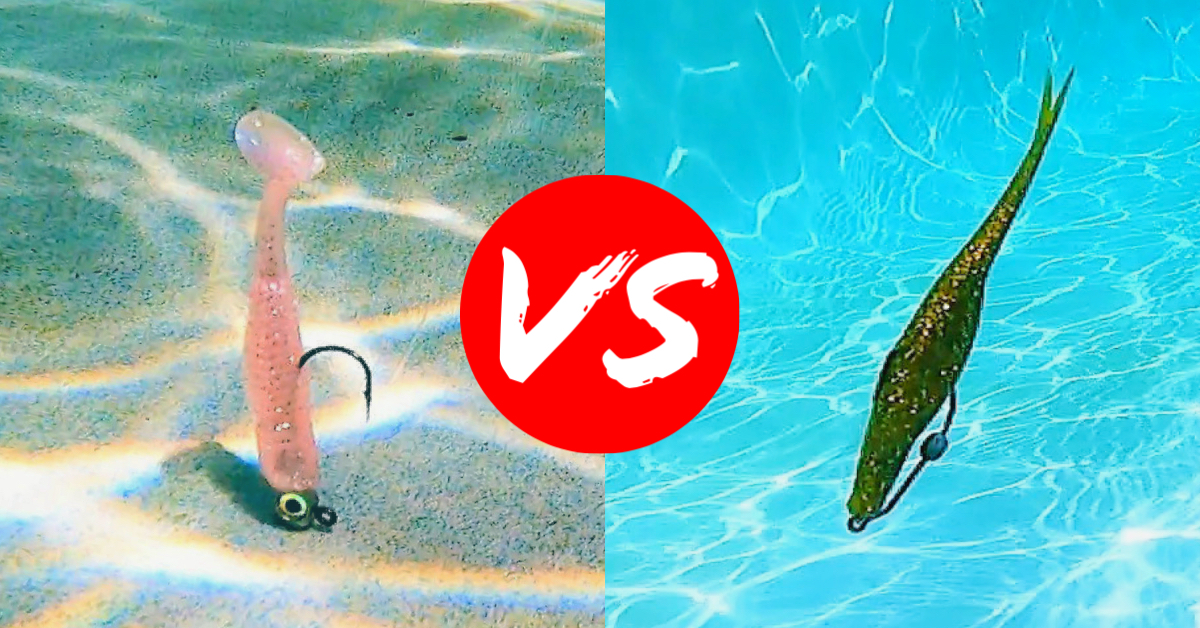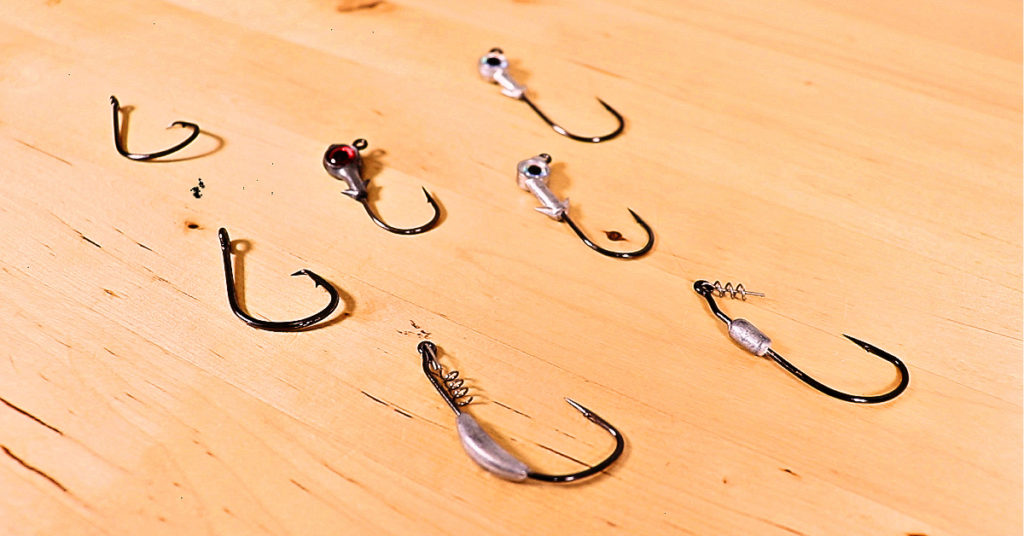Jigheads Vs. Weighted Hooks (How They Sink & When To Use)
- By: Justin Ritchey
- on

How do you know when you should use a jighead or a weighted hook on your soft plastic lure?
Is there a difference in presentation between the two hook styles?
Knowing what each type of hook looks like underwater can give you an advantage when presenting your lures to fish.
Check out more below!
Jigheads Vs. Weighted Hooks [VIDEO]

There are different hooks and jigheads for a plethora of applications and lures.
If you know what each presentation looks like underwater, then you can effectively choose the proper lure and hook pairing based on the fishing conditions.
Slam Shady 2.0 Paddletail
The Slam Shady 2.0 paddletail when rigged on an Owner Weighted Twistlock Hook creates an up and down bouncing motion when jigging.
Usually with soft plastics rigged on weighted hooks, they fall at a slight 45 degree angle when going down to the bottom.
But this is not the case with the Slam Shady 2.0 as it creates a vertical action with tail kicking on the way up and down.
However, the lure pauses at the peak of coming up and the tail freezes.
That pause can make a huge difference when fishing in shallow water scenarios.
When the Slam Shady 2.0 is rigged on a Z-Man Trout Eye Jighead, the lure falls much faster when jigging up and down.
Even if both weights of the weighted hook and the jighead were equal, the orientation of the jighead weight will pull the soft plastic down at a faster speed.
The jighead is a useful hook when fishing in deeper water of 5 feet or more to make contact with the bottom and bounce up.
Alabama Leprechaun
The Alabama Leprechaun when rigged on the Owner Weighted Twistlock Hook creates excellent, natural action.
As it bounces up and down there are slight pauses at the bottom and top.
Moreover, the lure stays in the strike zone for much longer because of the split tail design.
The pause in the strike zone lasts a lot longer than other soft plastic lures.
If you are fishing in shallow water scenarios, you don’t want to make contact with the bottom very quickly.
You want the lure to waft and hover to give off an injured baitfish appeal and entice the fish to strike.
More often than not, if your lure hits the bottom too fast in shallow water it can spook the fish rather than engage the fish.
When the Alabama Leprechaun is rigged on a Z-Man Trout Eye Jighead, the action is completely different than that of the weighted hooks.
The way the lure moves up and then descends is faster and more of a vertical straight up and down fall.
If you want to fish in shallow water of 2 feet or less, the Owner Weighted Twistlock Hook will better keep the jerk shad in the strike zone and will sink much slower.
In another scenario, you may want to use this lure to fish drop-off ledges and structure which would call for a jighead style hook.
If rigged on a jighead, this lure will make contact with the bottom faster and target different types of species.
Power Prawn
The Power Prawn is an extremely versatile and realistic shrimp imitation lure.
When rigged on an Owner Weighted Twistlock Hook, the Power Prawn moves like a wavelength in the water.
It creates an up and down motion with a slow descent.
The material the Power Prawn is made of is called TPE (Thermoplastic Elastomer) which is more buoyant than traditional soft plastics.
If rigged on an Owner Weighted Twistlock Hook, just like the Alabama Leprechaun, the Power Prawn will remain in the strike zone longer and will sink slower which is perfect for shallow water fishing.
The Power Prawn moves differently on a jighead compared to the other two lures previously tested underwater.
On a jighead, the Power Prawn achieves both a pause at the bottom and top of bounces as well as gains speed moving up and down vertically.
This setup will allow you to fish deeper areas effectively.
However, if you apply resistance to the line right before it makes contact with the bottom, the Power Prawn will scope out at an angle and flatten out.
This shows the lure can be efficient in shallow water as well if rigged on a lighter jighead.
The Power Prawn is a lure you definitely want to have in your arsenal of soft plastics when you head out to fish.
Conclusion

By knowing the underwater action of each lure rigged on different hook styles, you will better prepare yourself to fish several water columns and various depths.
It is all about figuring out which depth and column the fish are holding in and these different lures and setups will allow you to cover the most water possible.
Remember that the type of hook your soft plastic lure is rigged on matters and can have a severe impact on your lure’s presentation!
If you want to check out any of the lures and hooks mentioned, click on any of the links here:







And if you know someone who wants to understand the underwater action of lures based on hook choice, please TAG or SHARE this with them!
P.S. Want access to our best fishing spots and tips, plus discounts to our online tackle store? Click here to join us in the Insider Club!
Related Articles:
Related categories:
STOP WASTING TIME ON THE WATER!
Do what the “SMART ANGLERS” are doing and join the Insider Club.
Here’s what you’ll receive today when you join:
- Weekly fishing reports and TRENDS revealing exactly where you should fish every trip
- Weekly “spot dissection” videos that walk you through all the best spots in your area
- Exclusive fishing tips from the PROS you can’t find anywhere else
- Everything you need to start catching fish more consistently (regardless if you fish out of a boat, kayak, or land).










As usual for your instructional videos Justin, this was very clear and convincing regarding when to use a jig head and when to use a weighted hook. I don’t believe you mentioned the weight of each.
I’m going to much lighter 1/16th ounce, and, when I can find them the 1/32 ounce. Those lighter weights do occasionally present some challenges in certain wind conditions. Again Justin, just a really good video that is super helpful.
I would like to see the action of each of these lures in saltwater at 1/8 weight increments up to 3/4 oz. I am curious to see how deep these lures get on a Z-Man and Slam Shady.
More underwater videos to come soon, Steven! Thank you Sir 🙂
I’d like to see the rod action techniques needed to make the bait action shown on the video.
Good idea, Ray. I’ll discuss with the Team and see if we can get some better footage of different rods loading & unloading while working lures.
Justin can you do a video on top water lure presentation techniques and specifically what type of rod to use when wanting to perform a specific technique (ex. walk the dog). Also show us how to move the rod in order to get a specific technique.
Were the jig heads and hooks the same weight for each lure?
Indeed they were. In this particular video, I used Owner Weighted Twistlock in 3/0 and 1/8oz, and I had some Z-Man Trout Eye (Pearl) Jig Heads in 1/8oz as well. We carry the 3/16oz in Pearl on our Shop Page, but I still had some 1/8oz in Pearl that I’ve used in the past, so I kept the weights identical for this video. Hope that helps!
Justin, as others have said … this is a huge help in revealing just how that artificial looks underwater and the actions that an angler’s inputs makes to effectively fish each. This is why Salt Strong rocks … innovative content for all of us weekend warriors. Thanks!
Much appreciated, Buddy! Just a healthy reminder for all of us to check our setups to make sure they are performing as intended!
Outstanding video, Justin. Any thoughts on how current flow could impact the decision? Thinking specifically of the Northeast Florida screaming currents we can get at times. Thanks!
Ohhhhh yeah, Brother! After fishing with our New Coach (Richard) up in Jacksonville the other week, I can attest that having different sized jig heads is essential for fishing those currents up there! I stayed between 3/16oz and 1/4oz most of the time when we were fishing those 6-8′ drops off the edge of the grass. You gotta make contact with the bottom to fish effectively, so jig heads were a necessity in that scenario.
I really like a weightless twist lock hook when using a gulp jerk shad soft plastic, or Alabama leprechaun. Some other brands have salt content (zoom) , which increases the fall rate, and increases the casting distance. So it kinda makes up for no weight on the hook, and keeps the lure in a very horizontal position… with a slow fall rate. I almost always choose a weedless style hook compared to a jig head. Even when fishing deep, you can use twist lock hooks with heavier weights. This was an amazing video! Very insightful!
Oh yeah, definitely. When I fish for those larger (27″ and bigger) trout on shallow flats, sometimes a Gamakatsu EWG Worm Hook in 4/0 without a weight matched with a jerk bait can be deadly.
I tend to go with jig heads when I’m fishing any sort of current or water deeper than 6ft. I could try to jump up to a 3/16oz or 1/4oz weedless weighted hook, but it’s tough to fish those depths effectively with that style hook due to the placement of the weight. Ex: I opted for a 3/16oz jig head when fishing up in Jacksonville because that ripping current was near impossible to work a paddle tail on a weedless weighted hook in 5-6ft. Different tools for different situations.
More underwater video to come!
Wow what a great video. Seeing the lures under water differently rigged is huge. the slight difference between each type of lure and the same lures with different rigging is eye opening. Really great post, thanks Justin!
Glad you found it helpful, Robert! I thought it was pretty insightful too, if I do say so myself!
Great video. Appreciate you putting this together and sharing.
Thanks Matt! Glad you liked it. More underwater videos to come in the future.